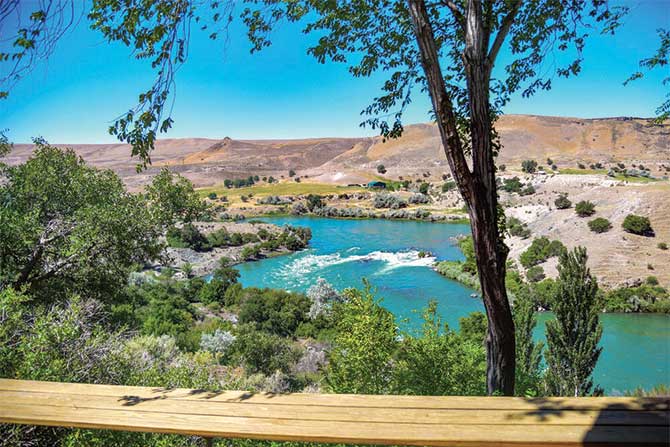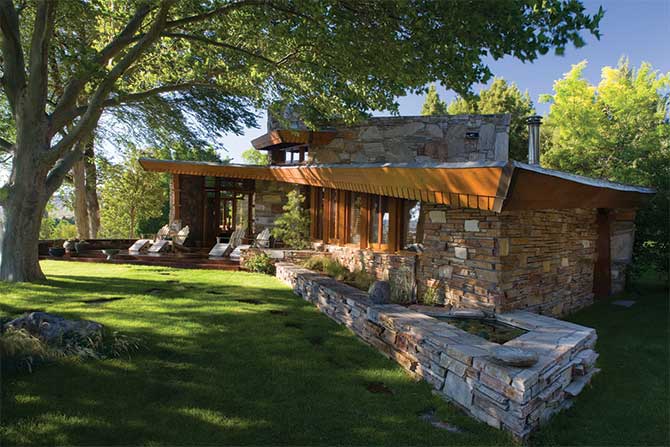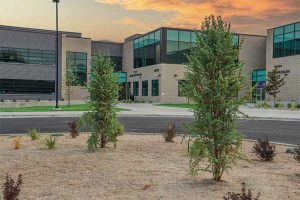By Krisjan Hiner
“The mission of an architect is to help people understand how to make life more beautiful, the world a better one for living in, and to give a reason, rhyme and meaning to life.”
— Frank Lloyd Wright, 1957
If you’ve never had the opportunity to visit a Frank Lloyd Wright building, I hope you have the chance sometime soon. Maybe it’s the mystique, the well-known and documented architectural significance or the hype, but visiting a Frank Lloyd Wright building is a near-divine experience.
I was fortunate enough to recently visit the Archie Teater Studio, also known as Teater’s Knoll, Idaho’s only Frank Lloyd Wright building, in Bliss, Idaho. Not only did I visit the site, but the property owner, Henry Whiting, gave me a private tour.
During our two-hour visit, we talked about architecture, music, furniture, art and life. To my surprise, our conversation was much more about life, family and relationships than architecture. Of course, we talked about architecture, Frank Lloyd Wright, design, furniture, and renovating and maintaining Teater’s Knoll. But after our conversation, as I was driving away, all I could think of were the people Henry talked about. The countless amazing-sounding people in Henry’s life that he would never have met if not for Teater’s Knoll. The people who were already in his life were brought closer together because of Teater’s Knoll. The experiences he had both at Teater’s Knoll and other Frank Lloyd Wright sites. How architecture literally shaped his life. The way that house and numerous other Frank Lloyd Wright buildings continue to bring people together.
Isn’t that what good design is supposed to do? Bring people together?
Finding the property isn’t exactly easy if you don’t know what you’re looking for. It’s outside of Bliss’s tiny town, Idaho, about 90 minutes east of Boise. The narrow winding road high above the Snake River is sprinkled with ranches amid the high desert. Teater’s Knoll is well-concealed behind a thicket of vegetation and a brown-painted wood wall and gate. The only signifying mark of the property is a small, understated teal-green-lettered sign with the words “Teaters Knoll.” Even using Google Maps, I sped past the property once, doubled back and found the small pull-out in front of the gate. As soon as I arrived, the gate opened and a friendly black dog ran out to greet me. Standing by the gate was my new friend Henry.
We walked inside and Henry pulled the gate closed. As we walked up the drive toward the front of the house, we exchanged pleasantries while I looked at the stunning home I’ve heard so much about. The house lies only 30 feet or so, from the road, but driving by, you would never know what was below. The first thing I noticed about the home was the color, texture, and rhythm of the Oakley stone swaddling the home. The rich, golden, earthy tones glowed in the midmorning sun.
The second detail I noticed was the view of the Snake River. The Snake River canyon is perfectly framed between the trees and two seat walls constructed from the same Oakley stone as the house from the entry. The placement of the home and the way it blends into the landscape is nothing short of perfect. Just as Frank Lloyd Wright indeed envisioned.
Before going inside, Henry and I stood outside the front door, chit-chatting and getting to know each other. At this early point in our interview, I realized that, as much as Henry loved his home, he loved the people and relationships he’s made because of the house as much, if not more.
The first of many stories Henry told me wasn’t about the home’s architecture, the anachronism of Wright and his work, or about the process of completely renovating the house. The first story he told me was about the lengths his father-in-law went to find him an authentic Frank Lloyd Wright red tile.
On the wall by the entry of certain Frank Lloyd Wright homes is a small red ceramic tile with Frank Lloyd Wright’s initials. These red tiles were reserved for projects with which the architect was notably satisfied. Buildings such as the Harold Price Sr. House in Paradise Valley, Arizona, Taliesin West in Scottsdale, the Solomon R. Guggenheim in New York, and numerous others all have the famous red tile. Frank Lloyd Wright did not give the Teater’s a red ceramic tile for one reason or another.

On the wall by the entry of certain Frank Lloyd Wright homes is a small red ceramic tile with Frank Lloyd Wright’s initials. These red tiles were reserved for projects with which the architect was notably satisfied.
Through an exalted series of friends, acquaintances, relatives, favors and relationships, Henry’s father-in-law was able to acquire a brand-new, authentic red Frank Lloyd Wright tile from the original maker. As Henry recounted his father-in-law, presenting him with the tile, he paused, holding back tears. For sure, the gift was meaningful and unique, but Henry was choked up not because of the gift itself, but because he so appreciated and loved his father-in-law.
Once we were inside, sitting on the couch in the main studio room beneath the iconic Teater’s Knoll grid-windows overlooking the prow and the Snake River, I had to ask, “So did this house find you, or did you find the house?” I knew this was a big question that had already been answered. I just wanted to know what he would say. Henry laughed and replied, “Have you read my book?” The perfect answer to a silly question. Indeed I had. In Henry’s book, “At Nature’s Edge, Frank Lloyd Wright’s Artist Studio,” Henry recounts how he came to know of Teater’s Knoll, his first experience peering over the fence to catch a glimpse, his purchase of the home, its renovation, the design and history of the studio and his life there.
As we continued to chat, Henry frequently mentioned his uncle Alden and referred to him as the most impactful person in his life. Uncle Alden Dow was a Frank Lloyd Wright apprentice in the early 1930s who went on to design numerous prolific buildings and heavily contributed to the architectural style that would come to be known as Michigan Modern. As Henry was narrating his introduction to and purchase of Teater’s Knoll, he recounted a trip to Florida to visit Uncle Alden and discuss his property’s possible procurement. Of course, uncle Alden thought purchasing this Frank Lloyd Wright home was a good idea. “If I were your father, I’d buy it for you,” said uncle Alden. “But I’m not and I won’t because if I did, it wouldn’t mean as much.”
Henry continued to tell me that shortly after purchasing the property, he flew to Arizona to visit the Frank Lloyd Wright Foundation at Taliesin West in Scottsdale to talk about his upcoming renovation and, hopefully, meet many of the professionals he had read about. Two people of significance Henry was able to meet were Tom Casey and Olgivanna Wright. Tom Casey was a Wright apprentice during the design of Teater’s Knoll and Olgivanna Wright was Frank Lloyd Wright’s widow. Both people had fond memories of Uncle Alden, and Henry again welled up talking about the experience of meeting both of them. Without Teater’s Knoll, Henry surely wouldn’t have met either of these people.



As we continued to talk, Henry radiated as he detailed the countless dinner parties, visitors, projects, trips, experiences, and relationships he built over the years in and around Teater’s Knoll and other Frank Lloyd Wright buildings.
The home’s interior is visually stunning, filled with art, furniture, and decor that complements and enhances every inch of the space. Some of the furniture pieces are one-of-a-kind hand-built works constructed from original Frank Lloyd Wright’s plans by Henry and one of his friends, a Sun Valley craftsman.
Much of the sculpture was created by Henry’s late wife, artist and sculptor Lynn Fawcett Whiting. As we toured the space, Henry described Lynn as someone who floated through life, living every day as if it were an art form. Henry described life with Lynn as joy, surprise and delight. We would all be so lucky to have someone like that in our lives — the perfect metaphor for life itself.
Seeing and experiencing this impressive building was a treat, for sure. Making a new friend and being reminded of the importance of and impact architecture can have on life was an experience I will always remember.










